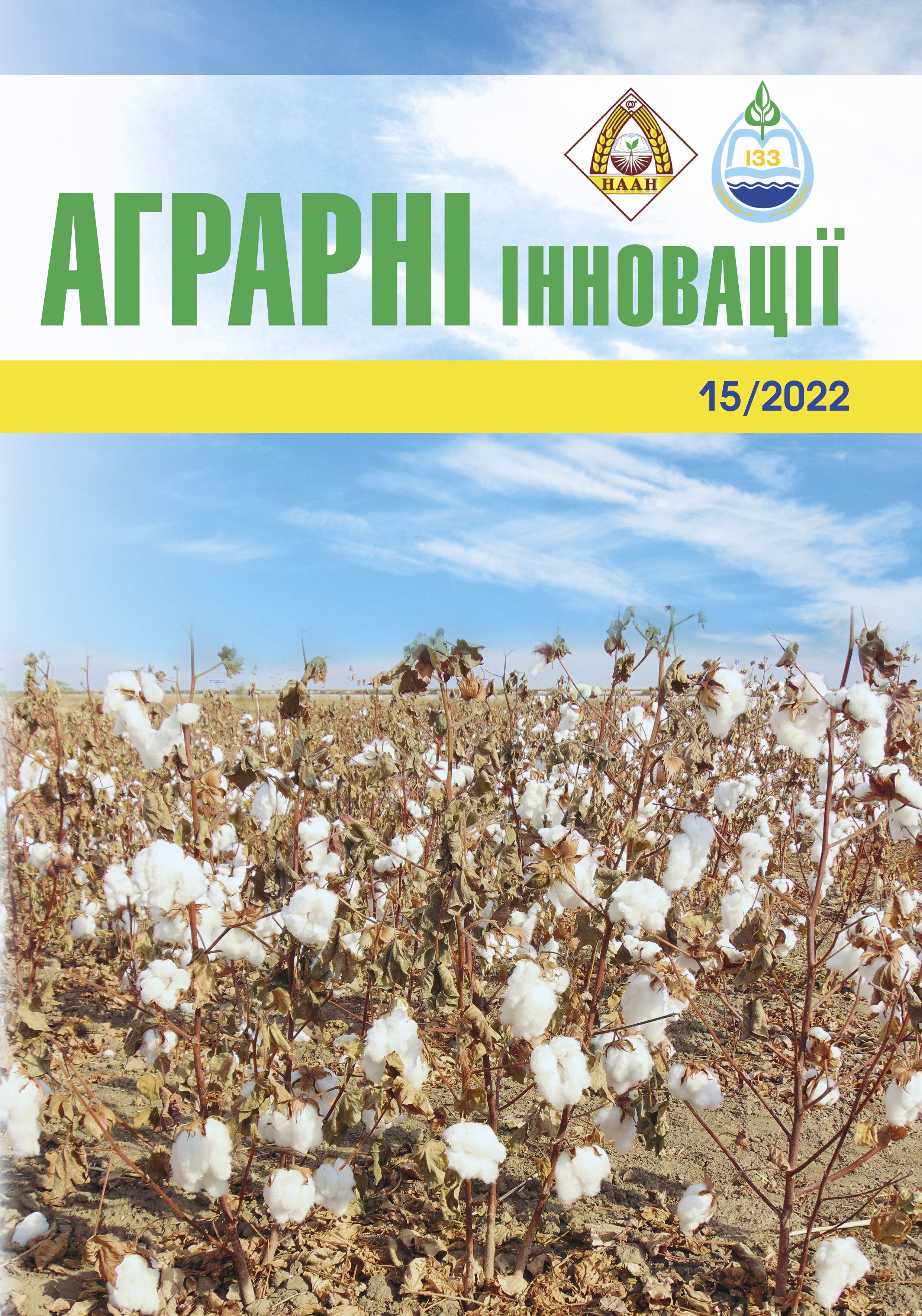Influence of pre-sowing seed treatment on the activation of the primary growth processes in winter wheat
Abstract
Purpose of the research is to determine the effect of pre-sowing seed treatment with chemicals for sterilization and disinfection on seed sowing quality and activation of growth processes in winter wheat seedlings. Methods. Gradual surface sterilization of the source material with solutions of 1% potassium permanganate, 96% ethanol and 0.1% silver nitrate was used. For further processing, fungicidal pesticides Raxil Ultra (tebuconazole) and Lamardor (tebuconazole + prothioconazole) were used, both separately and in mixtures with Gaucho (imidacloprid) insecticidal pesticide. Water treatment served as a control. Results. It was determined that chemical sterilization of seeds before germination helps to destroy the external infection, but leads to inhibition of the initial growth. The use of pesticides reduced germination energy and seed germination, but its effect on growth processes was ambiguous. The results of the studies show that pre-sowing seed treatment with various chemicals had an ambiguous effect on the development of oxidative stress. It was found that the use of Lamardor for pre-sowing seed treatment showed stimulating effect on the activation of primary growth processes in winter wheat plants. Conclusions. According to the complex characteristics of the effect of the studied treaters on seed sowing quality, Lamardor treater (tebuconazole + prothioconazole) was the optimal one, as it provided reliable protection against pathogens and contributed to active formation of seedlings and primary roots, the length of which exceeded the control variant by 29% and 7% in the stage BBCH 07 and 28%. and 43% in stage BBCH 10, respectively. In terms of dry matter content in coleoptiles and roots, this treatment variant was somewhat inferior to the control due to the increase in the activity of free radical processes. However, according to the complex characteristics of the germination process (energy index), the use of Lamardor for pre-sowing seed treatment contributed to the formation of the most viable plants.
References
2. Duveiller E., Singh R., Nicol J. The challenges of maintaining wheat productivity: pests, diseases, and potential epidemics. Euphytica. 2007. Vol. 157. P. 417–430. doi:https://doi.org/10.1007/s10681-007-9380-z.
3. Figueroa M., Hammond-Kosack K.E., Solomon P.S. A review of wheat diseases – a field perspective. Molecular Plant Pathology. 2018. Vol. 19. P. 1523–1536. doi: https://doi.org/10.1111/mpp.12618.
4. Aboukhaddour R., Fetch T., McCallum B.D., Harding M.W., Beres B.L., Graf R.J. Wheat diseases on the prairies: A Canadian story. Plant Pathology. 2020. Vol. 69(3). P. 418–432. doi: https://doi.org/10.1111/ppa.13147.
5. Strange R., Scott P.R. Plant Disease: A Threat to Global Food Security. Annual Review of Phytopathology. 2005. Vol. 43:83-116. P. 83–116. doi: https://doi.org/10.1146/annurev.phyto.43.113004.133839.
6. Jalli M., Laitinen P., Latvala S. The emergence of cereal fungal diseases and the incidence of leaf spot diseases in Finland. Agricultural and Food Science. 2011. Vol. 20(1). P. 62–73. doi: https://doi.org/10.2137/145960611795163015.
7. Ghimire B., Sapkota S., Bahri B.A., Martinez-Espinoza A.D., Buck J.W., Mergoum M. Fusarium Head Blight and Rust Diseases in Soft Red Winter Wheat in the Southeast United States: State of the Art, Challenges and Future Perspective for Breeding. Frontiers in plant science. 2020. Vol. 11. P. 1080. doi: https://doi.org/10.3389/fpls.2020.01080.
8. Hashidoko Y. Ecochemical studies of interrelationships between epiphytic bacteria and host plants via secondary metabolites. Bioscience, Biotechnology, and Biochemistry. 2005. Vol. 69. P. 1427–1441. doi: https://doi.org/10.1271/bbb.69.1427.
9. Barret M., Briand M., Bonneau S., Préveaux A., Valière S., Bouchez O., ... Jacques M.-A. Emergence Shapes the Structure of the Seed Microbiota. Applied and Environmental Microbiology. 2015. Vol. 81(4). P. 1257–1266. doi:10.1128/AEM.03722-14.
10. Nelson E. The seed microbiome: Origins, interactions, and impacts. Plant Soil. 2018. Vol. 422. P. 7–34. doi:https://doi.org/10.1007/s11104-017-3289-7.
11. Tkacz A., Cheema J., Chandra G., Grant A., Poole P. Stability and succession of the rhizosphere microbiota depends upon plant type and soil composition. The ISME Journal. 2015. Vol. 9. P. 2349–2359. doi: https://doi.org/10.1038/ismej.2015.41.
12. Munkager V., Vestergård M., Priemé A., Altenburger A., de Visser E., Johansen J., Ekelund F. AgNO3 Sterilizes Grains of Barley (Hordeum vulgare) without Inhibiting Germination-A Necessary Tool for Plant–Microbiome Research. Plants. 2020. Vol. 9(3). P. 372. doi: https://doi.org/10.3390/plants9030372.
13. Andrews S. Evaluation of surface disinfection procedures for enumerating fungi in foods: a collaborative study. International Journal of Food Microbiology. 1996. Vol. 29(2-3). P. 177–184. doi:https://doi.org/10.1016/0168-1605(95)00044-5.
14. Barampuram S., Allen G., Krasnyanski S. Effect of various sterilization procedures on the in vitro germination of cotton seeds. Plant Cell Tiss Organ Cult. 2014. Vol. 118. P. 179–185. doi: https://doi.org/10.1007/s11240-014-0472-x.
15. Lamichhane J., You M., Laudinot V., Barbetti M., Aubertot J.-N. Revisiting Sustainability of Fungicide Seed Treatments for Field Crops. Plant Disease. 2020. Vol. 104(3). P. 610–623. doi: https://doi.org/10.1094/PDIS-06-19-1157-FE.
16. Білоусова З.В. Оцінка адаптивного потенціалу сортів пшениці озимої (Triticum aestivum L.) в умовах Південного Степу України. Наукові доповіді Національного університету біоресурсів і природокористування України. 2018. № 3(73). URL: http://journals.nubip.edu.ua/index.php/Dopovidi/article/viewFile/dopovidi2018.03.013/9460 (дата звернення 13.10.2022).
17. Косаківська І.В., Бабенко Л.М., Скатерна Т.Д., Устінова А.Ю. Вплив гіпо- і гіпертермії на активність ліпоксигенази, вміст пігментів і розчинних білків у проростках пшениці сорту Ятрань 60. Физиология растений и генетика. 2014. Т. 46. № 3. С. 212–220.
18. Мусієнко М.М., Паршикова Т.В., Славний П.С. Спектрофотометричні методи в практиці фізіології, біохімії та екології рослин. Київ: Фітосоціоцентр, 2001. 200 с.
19. Kumar B., Verma S., Ram G., Singh H. Temperature Relations for Seed Germination Potential and Seedling Vigor in Palmarosa (Cymbopogon martinii). Journal of Crop Improvement. 2012. Vol. 26(6). P. 791–801.
20. Ellis R. Seed and seedling vigour in relation to crop growth and yield. Plant Growth Regul. 1992. Vol. 11. P. 249–255. doi:https://doi.org/10.1007/BF00024563.
21. Sen M., Jamal M., Nasrin S. Sterilization factors affect seed germination and proliferation of Achyranthes aspera cultured in vitro. Environmental and Experimental Biology. 2013. Vol. 11. P. 119–123.
22. Білоусова З.В., Кенєва В.А., Кліпакова Ю.О. Посівна якість насіння пшениці озимої залежно від компонентного складу протруйників. Вісник аграрної науки Причорномор’я. 2020. №3 (107). С. 79–86. doi:10.31521/2313-092X/2020-3(107)-10.
23. Bilousova Z., Klipakova Y., Keneva V., Kulieshov S. Influence of the Growth Regulator Application Method on Antioxidant Plant System Activity of Winter Wheat (Triticum Aestivum L.). Modern Development Paths of Agricultural Production / In V. Nadykto (Ed.). Springer, Cham, 2019. P. 615–622. doi:https://doi.org/10.1007/978-3-030-14918-5_60.






